You can’t always believe what you read… even when penned with good intentions…
May 6, 2024 by GuyHeilenman · Leave a Comment
(sarcasm alert)
Did you know you can obtain (collect) British newspapers older than the oldest known British newspapers?
While sounding a tad ridiculous, a newspaper article from a reliable 19th century publication confirms this claim.
Proof:
We recently discovered an article in an issue of the highly respected Niles’ National Register from 1839 which contained the following article: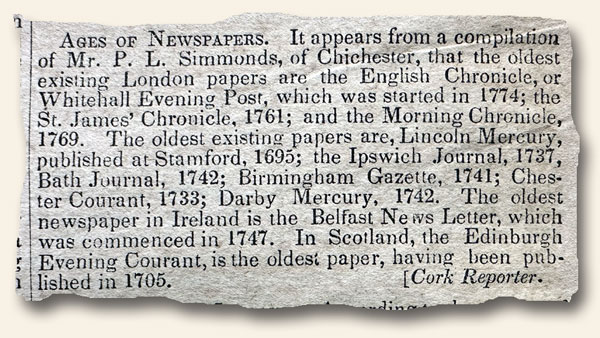
It appears that as of 1839, the oldest known “English” newspapers were from 1695. The problem? We have several to offer dated earlier. One might argue ours were discovered after this article was penned in 1839, but many of what we have are from The Times (London) whose claim to fame is being the oldest continuously published newspaper in England – perhaps the world(?), and was one of the more prominent newspapers from the 1600’s-1700’s. While the journalist may have been well-intentioned, the facts emphatically betray his/her research.
However, if you are one to believe everything you read, feel free to take a gander at…
British Newspapers Older than the Oldest British Newspapers
Snapshot 1903 – “Jack the Ripper” in America?
April 15, 2024 by GuyHeilenman · Leave a Comment
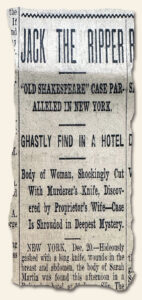 In the midst of what appears to be the steady decline of American culture, and the resulting tendency to develop a “woe is us” mindset which begins to long for the past, every now and then I come across a newspaper which serves as a reality check. Such was the case as I perused a Memphis Morning News dated December 21, 1903. The front-page alone had the following headlines: “No Safety for Americans” in Columbia, “Thieves Rob Jail”, “Killed All His Family”, “Russell Is Hurt” (student hits teacher in the head with a rock), “Mountain Bandit Escapes From Jail”, “Charles Nellens Arrested – Charged With Murder of Millionaire Wentz…”, “Saved Two Women From Fire”, “Preferred To Die – Charged With Postal Robberies, He Suicides”, and my favorite, “Jack The Ripper… Ghastly Find In A Hotel”. AND, I’ve yet to move past the front page. YIKES!
In the midst of what appears to be the steady decline of American culture, and the resulting tendency to develop a “woe is us” mindset which begins to long for the past, every now and then I come across a newspaper which serves as a reality check. Such was the case as I perused a Memphis Morning News dated December 21, 1903. The front-page alone had the following headlines: “No Safety for Americans” in Columbia, “Thieves Rob Jail”, “Killed All His Family”, “Russell Is Hurt” (student hits teacher in the head with a rock), “Mountain Bandit Escapes From Jail”, “Charles Nellens Arrested – Charged With Murder of Millionaire Wentz…”, “Saved Two Women From Fire”, “Preferred To Die – Charged With Postal Robberies, He Suicides”, and my favorite, “Jack The Ripper… Ghastly Find In A Hotel”. AND, I’ve yet to move past the front page. YIKES!
Truth be told, Western Culture (in general) and American Culture (specifically) are declining, but the call should be to right the ship for present and future generations, not to bury our heads in the sands of the past. Thanks to the slap in the face provided by this newspaper from 1903, I’ll get back to being thankful for all that is good in the present, while pushing for an even better tomorrow. Go back to life in 1903? No thank you – and WWI, the Spanish Flu, and the devastating Qing Famine are still far beyond the horizon. Note: The latter may not have been a “Western Culture” event, but when 20-30 million people die of starvation, it deserves a mention.
PS Spoiler alert. The Jack the Ripper headline is an early 1900’s version of what today would be labelled “click bait”.
This Month in History – March…
March 8, 2024 by GuyHeilenman · Leave a Comment
When considering the month of March what historical events come to mind? I’m sure if we each came up with a list of ten, while there may be some overlap, our lists would be quite diverse. A quick internet search turned up an exhaustive list which included the following:
- the “Articles of Confederation” was ratified
- the Lindberg baby was kidnapped
- FDR gave his “Fear Itself” speech
- the famous Woman’s Suffrage March took place in Washington, D.C.
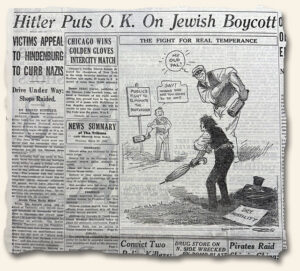 the Philippines gained independence
the Philippines gained independence- the Peace Corps was established
- Ulysses S. Grant became the commander of the Union armies
- Albert Einstein , David Livingston, and Wyatt Earp (among a long list of others) were born
- the Boston Massacre occurred
- the Equal Rights Amendment was passed by the Senate
- the Spanish Flu struck America
- Patrick Henry declared: “…give me liberty, or give me death!”
- the War in Iraq began
- the “Camp David Accord” was signed by Menachem Begin & Anwar Sadat
- the death of Isaac Newton
- Churchill gave his “Iron Curtain” speech
- the Civilian Conservation Corps (CCC) was founded
- the Soviet Republic of Georgia declared their independence
Collectors of rare and early newspapers know that coverage of such events can nearly always be found in old newspapers; however, one of the added pleasures is discovering reports of previously unknown or long-forgotten events which inspire a deeper look – aiding the lifelong learning process which helps to keep us mentally engaged as we progress through life.
The link below will take you to a reverse-chronological list (1600’s-20th century) of our currently available newspapers from the month of March. There’s no need to buy anything. Simply enjoy your march backwards through time.
“Yes, Virginia, there is a Santa Claus”…
December 13, 2023 by GuyHeilenman · Leave a Comment
The world-famous article shown below appeared in THE (New York) SUN on September 21, 1897. It is certainly one of the most challenging issues to collect as few are known to exist. It has been said this may very well be the most recognized editorial of all time. Found on page 6 and headed: “Is There a Santa Claus?”, this is the famous “Yes, Virginia, there is a Santa Claus” editorial written by Francis Pharcellus Church, a sardonic Columbia College graduate & veteran Sun writer, he produced a masterpiece in fewer than 500 words.
Although the letter from Virginia and the famous response by Church have become well known (translated into 20 languages), few would know the prefacing paragraph which immediately precedes Virginia’s letter: “We take pleasure in answering at once and thus prominently the communication below, expressing at the same time our great gratification that its faithful author is numbered among the friends of The Sun:…” and then Virginia’s letter and Church’s response.
The famous phrase “Yes, Virginia, there is a Santa Claus…” begins the second paragraph, and the letter closes with: “…No Santa Claus! Thank God! he lives, and he lives forever. A thousand years from now, Virginia, nay, ten times ten thousand years from now, he will continue to make glad the heart of childhood.”
The press tracked Virginia until her retirement as a 70-year-old school teacher, while Church remained anonymous as the author until his death in 1906.
As for Church, he was a hardened cynic and an atheist who had little patience for superstitious beliefs, did not want to write the editorial, and refused to allow his name to be attached to the piece. More than a century later, it is the most reprinted editorial in any newspaper in the English language. This reality is a great reminder to all of us to always give our best effort, even when we don’t necessarily agree with those whom are in authority over us – moral conflicts accepted.
So, for a few brief moments let’s set aside the weight of “enlightenment” which is pressed upon us by virtue of adulthood and attempt to appreciate the sweet exchange between a “cynical” journalist and a curious, yet innocent, young girl. Merry Christmas and Happy Holidays to ALL!
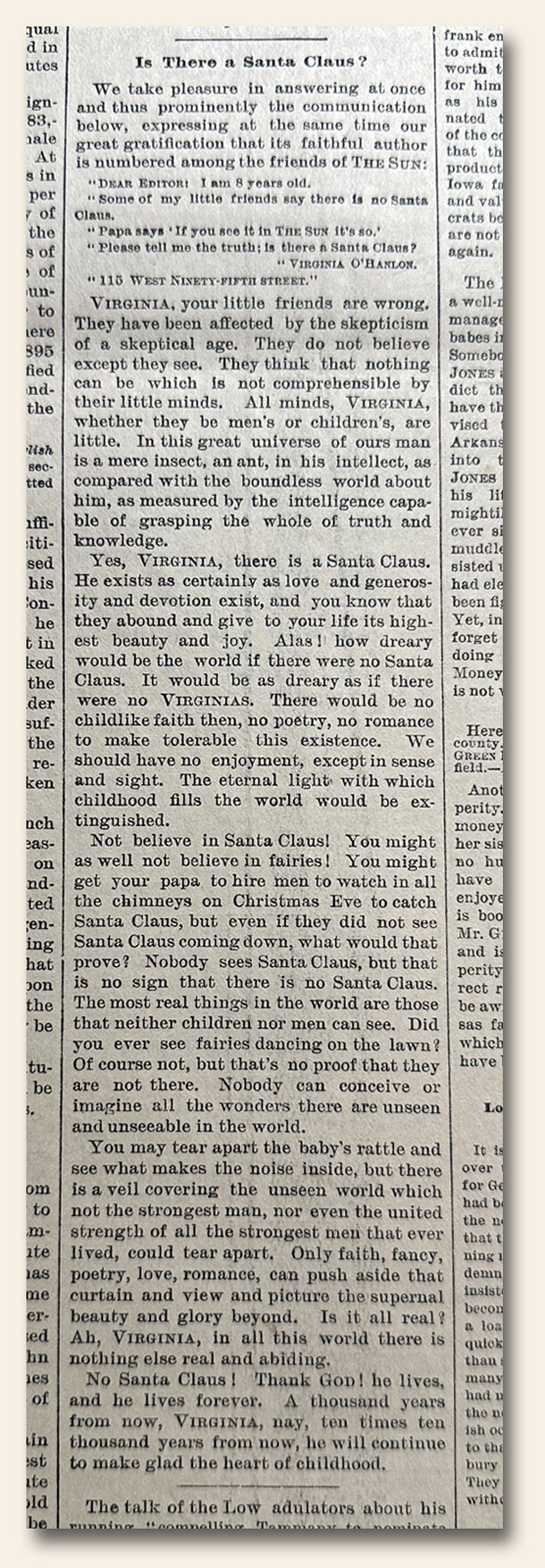
The reason I collected it: Dodge’s Literary Museum…
August 21, 2023 by TimHughes · Leave a Comment
Mastheads of newspapers through the centuries offer a very wide assortment of styles, sizes and decorativeness, with many being quite mundane. Only the “special” ones make it to the private collection, and “Dodge’s Literary Museum” is one.
Any newspapering which the masthead consumes one-third of the front page qualifies. This title’s masthead engraving consumes over half of the front page, very unusual as such. The content may be literary items with no “newsy” reports, but the front page is certainly worth of collecting, regardless of what is inside. 21
21
The Stuff of Legends… Paul Revere and his ride into near-mythical status…
August 8, 2022 by Laura Heilenman · Leave a Comment
 Whether it is an Ian Flemming Novel or one by Sir Arthur Conan Doyle, there is something about cloak and dagger … slinking through the shadows or breath-catching action which captures the imagination. If one is able to combine these with a real-life story, all the better! I would argue such is the case with The Midnight Ride of Paul Revere. Inspiring both children, from their earliest years in school, to great poets and artists in their time, Paul Revere exhibited both courage and savvy to evade the British in passing along his critical cry of warning. On December 5, 1795, The COLUMBIAN CENTINEL Boston, gives the account of Paul Revere’s legendary ride on the eve of the battle of Lexington and Concord. The best spy account in American History? I’ll let you decide.
Whether it is an Ian Flemming Novel or one by Sir Arthur Conan Doyle, there is something about cloak and dagger … slinking through the shadows or breath-catching action which captures the imagination. If one is able to combine these with a real-life story, all the better! I would argue such is the case with The Midnight Ride of Paul Revere. Inspiring both children, from their earliest years in school, to great poets and artists in their time, Paul Revere exhibited both courage and savvy to evade the British in passing along his critical cry of warning. On December 5, 1795, The COLUMBIAN CENTINEL Boston, gives the account of Paul Revere’s legendary ride on the eve of the battle of Lexington and Concord. The best spy account in American History? I’ll let you decide.
Journalism from Early America to the Digital Age… Election Fraud and more…
June 10, 2022 by GuyHeilenman · Leave a Comment
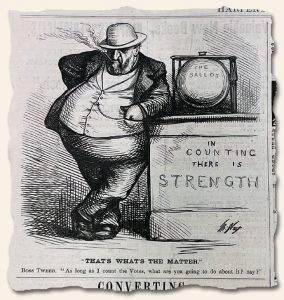 Someone recently brought to my attention an article posted on the website “Brewminate: A Bold Blend of News and Ideas”. While scanning the article I was intrigued by the presence of illustrations of newspapers we have or have previously offered. One in particular which caught my attention was the timely political cartoon by Thomas Nast found in the Oct. 7, 1871 issue of Harper’s Weekly. While a degree of election fraud is (unfortunately) part-and-parcel of the election process, I was inspired to read through the entire article, and in so doing, found it to be quite informative… and wondered if the friends of Rare & Early Newspapers might also find it interesting. Hopefully you will also enjoy reading it:
Someone recently brought to my attention an article posted on the website “Brewminate: A Bold Blend of News and Ideas”. While scanning the article I was intrigued by the presence of illustrations of newspapers we have or have previously offered. One in particular which caught my attention was the timely political cartoon by Thomas Nast found in the Oct. 7, 1871 issue of Harper’s Weekly. While a degree of election fraud is (unfortunately) part-and-parcel of the election process, I was inspired to read through the entire article, and in so doing, found it to be quite informative… and wondered if the friends of Rare & Early Newspapers might also find it interesting. Hopefully you will also enjoy reading it:
“Journalism from Early America to the Digital Age”
Newspaper Curiosities in 1867 from the Harper’s New Monthly Magazine…
February 28, 2022 by Stephanie Williams · Leave a Comment
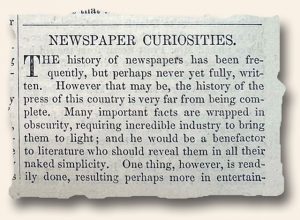 In a strange twist within this unique collecting niche, I came across a nine-page essay within the Harper’s Monthly of September 1867. Imagine my interest in uncovering the following opening:
In a strange twist within this unique collecting niche, I came across a nine-page essay within the Harper’s Monthly of September 1867. Imagine my interest in uncovering the following opening:
The history of newspapers has been frequently, but perhaps never yet fully, written. However, that may be, the history of the press of this country is very far from being complete. Many important facts are wrapped in obscurity, requiring incredible industry to bring them to light; and he would be a benefactor to literature who should reveal them in naked simplicity.
The author (whose name I cannot discern recorded within the volume) begins with the first press, “established in Cambridge, Massachusetts, eighteen years after the landing of the Pilgrims, where it was operated for forty years without a rival in America.” He goes on to say that 1644 marked the appointment of “censors of the press”, and that Boston saw its first press thirty years later, and that the Boston News-Letter reported the news from Europe — thirteen months after the fact. There are many interesting details quoted concerning the earliest days of colonization, followed by the appearance of the New England Courant, the American Weekly Mercury, the Pennsylvania Gazette, the Boston Evening Post and the Pennsylvania Journal and Weekly Advertiser, all of which preceded the dailies begun with the Pennsylvania Packet in 1794.
One appealing aspect of this article, beyond the timeline which includes excerpts from most of the earliest papers, is the outside perspective. The writer acknowledges that all we can know is limited to the information reported, subject to a selection process influenced by the motivation/perspective/experience of the editor. Thus it has always been, and likely will always be.
They put it in print – an 1877 opinion of The Press…
January 6, 2022 by Laura Heilenman · Leave a Comment
Sometimes a picture says it all. The illustration below was printed in a Harper’s Weekly dated June 2, 1877, but left undated some might think it is a recent print. Do these “1000 words” from the 19th century, in fact, have staying power? You decide.
I’m New Here: A Few Changes…
January 31, 2020 by Stephanie Williams · Leave a Comment
This week has gone by in a blur. The (exciting) new catalog ships out tomorrow, and all the attendant hoopla has filled our schedules. It’s always a juggling act to maintain regular work around special projects, because there is plenty of the latter to pack our days.
A seasoned collector was filling gaps prior to an approaching exhibit, and he called to have me check a New York Times obituary in 1898.  We didn’t have the date it ran, and I exhausted all the other major papers. However, the deceased was an abolitionist who also contributed to the effort to gain the vote for women. As a last ditch effort I pulled a volume of the Woman’s Journal from Washington DC, and found a lengthy tribute to Robert Purvis. Mr. G was quite pleased, and I felt triumphant with my find, particularly as it led me to delve into my favorite category – publications in which women played an important role. Although much content pertains to suffrage, there seems to have been an effort to provide a platform for intelligent discussion that encompassed many other aspects of life in the 1800’s. These journals are a valuable resource for a look into the 19th Century, and I am always glad to fulfill an order with one of these gems.
We didn’t have the date it ran, and I exhausted all the other major papers. However, the deceased was an abolitionist who also contributed to the effort to gain the vote for women. As a last ditch effort I pulled a volume of the Woman’s Journal from Washington DC, and found a lengthy tribute to Robert Purvis. Mr. G was quite pleased, and I felt triumphant with my find, particularly as it led me to delve into my favorite category – publications in which women played an important role. Although much content pertains to suffrage, there seems to have been an effort to provide a platform for intelligent discussion that encompassed many other aspects of life in the 1800’s. These journals are a valuable resource for a look into the 19th Century, and I am always glad to fulfill an order with one of these gems.
As I begin this second year here at Rare & Early Newspapers, I am planning to dedicate my last post each month to a look at our titles, beginning with the Woman’s Journal. Hopefully, I can unearth enough nuggets that you will all start to consider that a collection cannot possibly be complete without containing at least an issue or two from the Woman’s Tribune, The Woman’s Journal, The North Shore Review, the Ladies Magazine or Womankind.
Thank you for the kind comments and encouragement in this first year. I beg your continued forbearance as I wade more deeply into the water.
Cheers!



